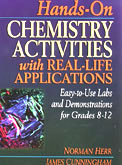
TEACHING PHYSICS
In this session we will discuss ways of integrating simulations , probeware, and hands-on activities when teaching physics to secondary school students.
(1) Internet-Based Experiments
Although computer simulations are not adequate substitutes for traditional hands-on experiments, they may be useful enhancements. Select an on-line simulation such as one of the following and write a brief lesson plan showing how this simulation can be integrated with hands-on activities to improve instruction.
(2) Modeling Physics Experiments with Software (Interactive Physics) Knowledge Revolution:
(a) Basketball: Change the velocity of the ball or the elasticity of the backboard to sink the shot in order to make the basket.
(b) Earthquakes: The effects of an earthquake can be studied using the earthquake file. Adjust the number of springs and/or the spring constants to determine the conditions necessary to topple the third story of the "building".
(c) Rocket stabilization: Run the Lunar Lander file and note that an off-center force created by a shifting payload can cause a crash. Is a shifting payload more dangerous when taking off from the Moon or from the Earth? Explain. Is the effect more serious if the mass of the shifting payload is large or small? Real rockets have engines that adjust the direction of their thrust during flight to counteract such problems. Apply an additional force to the lunar lander so that it can lift off successfully from the Earth with a 400 kg shifting payload.
(d) Shooting gallery: A target is dropped the instant a gun is fired. Should the marksman aim at the target, above the target, or below the target in order to intercept it as it falls? Use Fun Physics or Interactive Physics to design an experiment that answers this question. With tracking and component vectors on, run the experiment, and stop it at the moment the projectile intercepts the target.
(e) Falling Objects Galielo said that objects accelerate to the earth at the same rate, regardless of mass. Design an experiment using Fun Physics to test this. Compare the velocity of impact of these objects with the velocity of similar objects dropped from the same height on the moon.
(f) Factors affecting the period of a pendulum. Is the period of a pendulum dependent upon its length, mass, or both? Design an experiment in Fun Physics to answer this question. Compare your results with real pendulums in the labs.
(g) Simple Harmonic motion. Do a pendulum or a spring exhibit simple harmonic motion? Graph the velocity (vx or vy) or position (x or y) or a pendulum to find out.
(h) Velocity and acceleration: Design an experiment that monitors the vertical position, velocity, and acceleration of a projectile. Include a printout similar to the figure below. What is the relationship between velocity, and acceleration?
(i) Collisions: Perform the following experiment using real spheres, and then test it using Fun Physics. Include a printout of your experimental design as well as a written summary of your findings.


 |
Hands-On Physics Activities with Real-Life Applications (Cunningham & Herr)